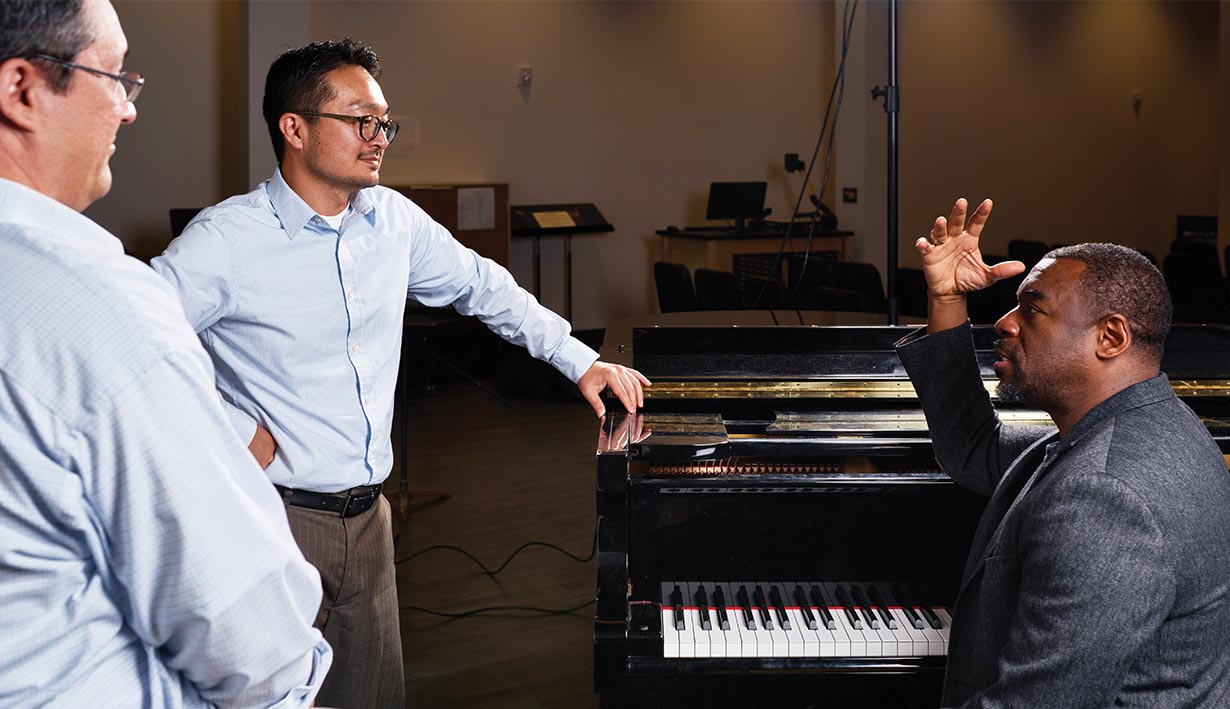The Bible & Theology Toward Christian Maturity
Songs of a Prophet
Faculty engage the book of Hosea through study and music
By Deanna Duff | Photo by Garland Cary
 Left to right: SPU faculty members Daniel Castelo, Bo Lim, and Stephen Newby have found multidisciplinary, collaborative ways to study Scripture in their scholarly and creative work.
Left to right: SPU faculty members Daniel Castelo, Bo Lim, and Stephen Newby have found multidisciplinary, collaborative ways to study Scripture in their scholarly and creative work.
Stephen Newby gradually began hearing the music in his mind. In 2013, the associate professor of music began studying the book of Hosea in an SPU seminary class taught by Associate Professor of Old Testament Bo Lim. He came to the text with passing familiarity, but heard inspiration as he dug deeper.
“I was in my study meditating on Hosea 6:6: ‘I desire mercy, not sacrifice, and acknowledgement of God.’ I got up and immediately went to the piano. My hands began playing chords, giving shape and form to the melody in my head,” Newby says. Sitting at his baby grand piano, the ultimate result was an oratorio blending elements of gospel, jazz, and classical music — genres in which Newby has composed and performed for decades. Drawing on his African-American roots and the tradition of “dancing before God,” Newby also incorporated tap dancing into the final movement. The piece premiered to thunderous approval during SPU’s 2015 gospel choir concert. Selections have since been performed at numerous chapel services.
“The book of Hosea is a tough text and there isn’t much music wrestling with it,” Newby says. “For me, it’s about three things: how we stray from God and how we’re ultimately restored and redeemed. Also, there is the general lesson of how much more we can learn from Biblical texts when we closely engage with them.”
The course Newby took was also part of a collaborative study of the text of Hosea. Lim, who is also university chaplain, collaborated with Daniel Castelo, professor of dogmatic and constructive theology. In 2015, the two faculty members published a biblical commentary on Hosea as part of the Two Horizons Old Testament book series.
The book employed the unique approach of combining their respective areas of expertise in biblical scholarship and theology. According to Lim, such teamwork remains rare. For them, the success of the endeavor was rooted in their personal friendship as much as their professional relationship.
“We wanted to maintain the integrity of our own disciplines and yet be in genuine conversation. That’s often talked about as the ideal, but rarely executed,” Lim says. “The resulting work really encourages the reader to learn from distinct voices.”
They addressed themes that challenge them both as scholars and as Christians — sexual imagery and language, violence, infidelity, and scandal. Lim also cites the fragmented structure as a common obstacle, “like glass shards broken into 100 bits and pieces.”
“We shouldn’t give up on a text like Hosea because of its controversial metaphors and images. We also shouldn’t manipulate or romanticize it to fit or own understandings,” Castelo says. “Take the time to deliberately work through it.”
Castelo and Lim broadened the conversation by involving colleagues, students, and community members. Castelo taught a six-month, adult Sunday school series at First Free Methodist Church that he says provided invaluable insights to how lay readers relate to the book of Hosea. Lim taught two SPU seminary classes focusing on work. Among those students was Newby. It was a synergy of learning whereby Newby’s participation contributed to the book and that simultaneously sparked his musical interpretation.
“This is the type of innovative, multidisciplinary work SPU strives for,” Lim says. “Each voice contributes to a greater whole, but with a distinct perspective. The liberal arts education profoundly converges with scripture-focused worship. That is an inspiring experience.”
